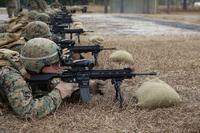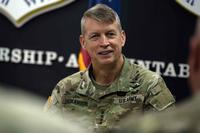Russia gave the U.S. military brief notice that its bombers were coming from a base in Iran for the first time to hit targets in Syria, an American military spokesman in Baghdad said Tuesday.
"The Russians did notify the coalition" under the memorandum of understanding on flight safety over Syria that was agreed to by the two countries, said Army Col. Chris Garver, a spokesman for Combined Joint Task Force-Operation Inherent Resolve.
"They informed us they were coming through" with Tu-22M3 long-range bombers, known as "Backfires" by NATO, and Su-34 tactical bombers, Garver said. "We assured safety of flight as those bombers passed through the area and toward their target and then when they passed out again," he said.
Garver declined to say how much warning the U.S. had of the Russian overflights. "We knew in time," he said, adding that it was "not a lot of time but it was enough."
The spokesman also declined to say whether U.S. and coalition aircraft over Iraq and Syria had to alter their own flight plans to accommodate the Russians. He repeated that the Russian route in and out "did not impact coalition operations."
Related Video:
Russia's Defense Ministry said Tuesday its warplanes took off from a base in Iran to target Islamic State fighters in Syria. The Ministry released a video of planes dropping bombs that were said to be targeting the IS militants. (AP)
The Russian bombers took off from a base near the Iranian city of Hamedan, about 175 miles southwest of Tehran, in what was believed to be the first use of an Iranian airfield by a foreign power to bomb a third country since the Iranian revolution of 1979.
Iran's Secretary of the Supreme National Security Council, Ali Shamkhani, said the use of the airfield was a sign of the growing strategic alliance between Russia and Iran. He said that Moscow and Tehran "enjoy strategic cooperation in the fight against terrorism in Syria and share their facilities and capacities to this end," official state media reported.
The Russian airstrikes into Syria from Iran came as the U.S. and Russia were still at odds over a possible agreement brokered by Secretary of State John Kerry to cooperate in a campaign against ISIS in Syria.
A day before the airstrikes, Russian Defense Minister Sergei Shoigu said the proposed agreement would "allow us to find common ground and start fighting together for bringing peace to that territory."
Shoigu added Russian negotiators were "in a very active stage of talks with our American colleagues" but there was no confirmation from the American side that an agreement was near.
In a video briefing from Baghdad to the Pentagon, Garver said that the Russian bombers hit targets in northern Aleppo and Idlib, and also in eastern Deir al-Zour. Garver said there was a presence of Islamic State of Iraq and Syria fighters in Deir al-Zour but not in Aleppo or Idlib. "We don't see a concentration of ISIS in those areas," he said.
Also in Syria, Garver confirmed that a convoy of hundreds of ISIS fighters using civilians as human shields was allowed to exit the key northeastern stronghold of Manbij, which fell last weekend to forces of the U.S.-backed Syrian Democratic Forces.
The convoy proceeded to the north, but Garver declined to say whether it crossed the Turkish border. He said U.S. warplanes tracked the convoy but "they let the convoy continue to travel. They couldn't engage it" because of the presence of the civilians, he said.
-- Richard Sisk can be reached at Richard.Sisk@Military.com.




























